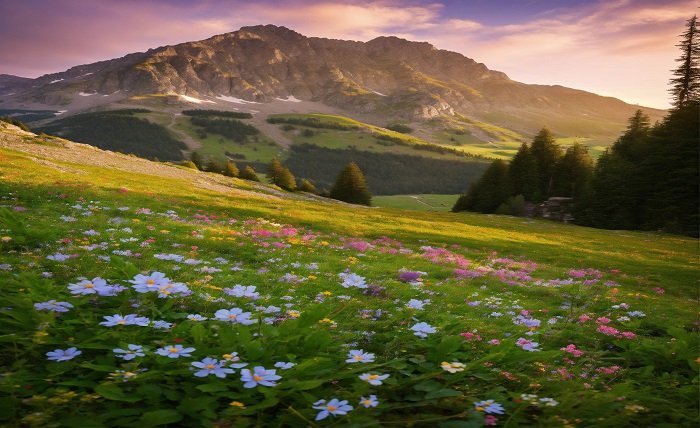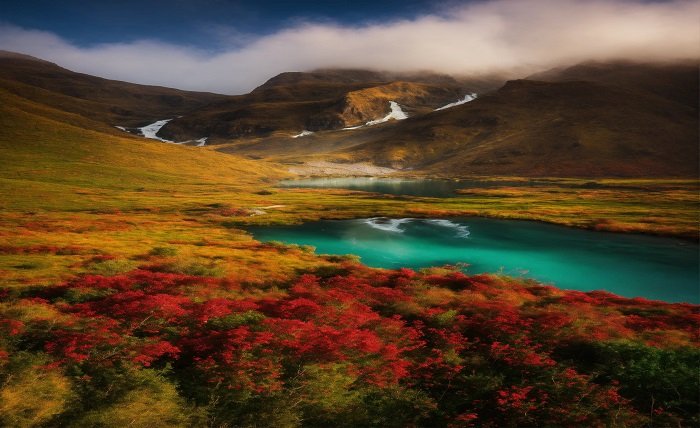One of the most beautiful and distinctive habitats in nature is the alpine ; tundra. This scene, tucked away at high altitudes, provides a window into a world where beauty and survival live in precarious balance. This blog article will explore the fascinating features of alpine tundra, including its biological significance, flora and wildlife, and problems.
Alpine Tundra: What is it?

The biome known as “alpine” tundra” is located in mountainous areas above tree lines, where the climate is too hostile for trees to flourish. It is the freezing temperatures, severe winds, and brief growth seasons that define this biome. Despite these harsh circumstances, a wide variety of plant and animal species that are specially adapted to this habitat can be found in the alpine tundra.
Alpine Tundra Flora: Adapting to Adversity
To survive in such hostile environments, plants in the alpine” tundra have evolved amazing adaptations. Low-growing perennial herbs, lichens, mosses, and tiny shrubs are examples of common vegetation. These plants can perform photosynthesis in cold temperatures and frequently have extensive roots to stabilize them against high winds. Certain species, like the Arctic willow, are smaller copies of their relatives that grow in milder climates.
The Alpine Tundra’s Fauna: Surviving Against the Odds
With species specially adapted to the frigid, windy, and low-oxygen circumstances, the animal life of the alpine” tundra is equally fascinating. The marmot, pika, and mountain goat are among the notable inhabitants. To endure the cold winters, these creatures have evolved fat storage, protective fur, and burrowing or hibernating habits. The alpine tundra is home to birds such as the snow sparrow and the golden eagle, who have demonstrated incredible adaptations to this difficult environment.
The Alpine Tundra is important for ecosystems.
The alpine – tundra is essential to the world’s ecosystem. Major rivers are fed by snowfields and glaciers, which act as an essential supply of water. In addition to absorbing and storing carbon dioxide, the tundra’s plant life also serves as a carbon sink, slowing down global warming. In addition, the distinct richness of the alpine “tundra offers insights into the survival and adaptation of species, supporting the general health of global ecosystems.
The Alpine Tundra and Climate Change: A Precarious Balance
The alpine” tundra is being threatened by climate change. The delicate equilibrium of this ecosystem is susceptible to disruption due to rising temperatures and modified precipitation patterns. The availability of water downstream may be impacted by the melting of snowfields and glaciers brought on by warmer temperatures. Furthermore, shifting environmental factors can encourage the incursion of trees and other species that aren’t typically found in alpine tundra, which could result in the extinction of local wildlife.
The effects of humans on the alpine tundra: conservation issues
For the alpine tundra, human activities like development, mining, and tourism provide new difficulties. Foot traffic increases have the potential to erode soil and harm delicate plants. The fragile balance of this ecosystem is further threatened by pollution and habitat degradation. To preserve these exceptional landscapes, conservation activities are crucial and should include strategies like responsible tourism, habitat restoration, and legislative safeguards.
Alpine Tundra Exploration: A Call to Adventure
The alpine- tundra offers amazing scenery and rare wildlife encounters for people looking for adventure. In these high-altitude areas, hiking, wildlife viewing, and photography are popular pastimes. But you must approach these tasks with consideration for the environment and with respect. For the benefit of future generations, conserve the alpine tundra by adhering to Leave No Trace guidelines, staying on authorized trails, and supporting conservation initiatives.
In summary
The persistence and beauty of nature are exemplified by the alpine tundra. Its distinctive flora and fauna, ecological significance, and difficulties underscore the necessity of ongoing conservation efforts. We can help preserve this extraordinary biosphere and make sure that it inspires and supports life for future generations by learning about and appreciating it.
FAQ
What does an alpine tundra look like? Mountainous areas above the tree line are home to the alpine tundra biome, which is distinguished by its chilly temperatures, biting winds, and brief growing season.
How can plants thrive in the tundra of the highlands? To withstand severe conditions, plants in the alpine tundra have evolved deep roots, low-growth forms, and the capacity to photosynthesize at low temperatures.
Which creatures inhabit the alpine tundra? Mountain goats, pikas, marmots, snow finches, and golden eagles are among the common creatures that have adapted to the low oxygen and cold temperatures.

